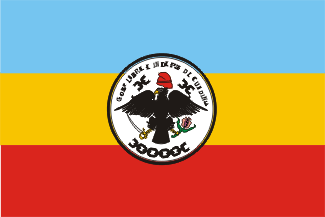
image by Jaume Ollé

Last modified: 2006-06-09 by dov gutterman
Keywords: cundinamarca | colombia | bogota | santafe de bogota |
Links: FOTW homepage |
search |
disclaimer and copyright |
write us |
mirrors
See also:
On 21 July 1810 appeared, in Santa Fe,
cockardes, banners, bands and flags with the colors yellow and
red. They must means that spanish colors were recognized since
the Junta in Santa Fe, established day before, recognized the
spanish king Fernando VII and the regency government of Cadiz.
The colors were the orign of the current Bogota flag (Santa Fe
full name was Santa Fe de Bogota, now known only as Bogota).
Those colors were used mainly by the so-called Junta de San
Victorino, a popular leadership of the revolt, that on 26 July
obtain decision that the Junta recognizes only the King Fernando
VII but not the regency of Cadiz since Santa fe wanted to be
autonomous, only under the same king as Spain. However, on 16
August 1810 a more moderate autonomist fraction took power. Those
colors were used by the militias of the province of Santa Fe in
1811. On 27 February 1811 santa Fe was converted into the state
of Cundinamarca (recognizing the spanih King) and constitution
was issued on 30 March 1811.
On 7 August 1813 the State of Cundinamarca flag was adopted,
adding a celest stripe to the flag. There is a mistake f of some
vexillologist which attribued the meaning of sea to the blue the,
even Philippe mentions that the flag with seal must have been the
naval ensign. It is quite clear that no ensigns were created by
Cundinamarca because is in inner land, very very far to the coast
and without rivers or lakes. Flag must be only national, civil
and state flag on land and with seal (and inscriptions) as the
military flag. Since is not any exemple available of the military
flag, reconstruction was made according to the text of the law.
Flags of Cundinamarca were plain triband as civil
(and probably state) flag on land, triband with seal (very
similar to the current provincial flag) is doubtefoul (perhaps
state flag on land). Perhaps there is a confusion with the
presidential flag which is certainly the triband with seal but
with motto in the seal which is different from the motto in the
national seal. Square triband with black inscriptions and seal is
a reconstruction of the military flag from Restrepo (JHS and
CUNDINAMARCA inscriptions were added because they are quoted in
the law text but they are not drawn in Restrrepo). Square triband
with gold inscriptions is my reconstruction (the l>aw don't
mention seal neither chains and motto, but only eagle and cap,
and it didn't gave the colour and position of the inscriptions
that I placed in the most normal form and in the most frequent
color for embrodoined inscriptions).
Jaume Ollé, 15 September 2001
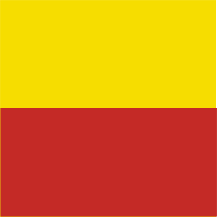
image by Jaume Ollé, 15 September 2001
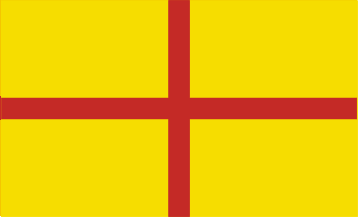
image by Jaume Ollé, 15 September 2001

obverse
image by Eugene Ipavec and Jorge Candeias, 30
May 2006
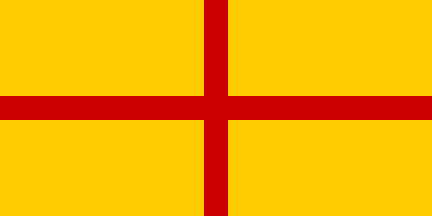
reverse
image by Jorge Candeias, 30 May 2006
From <www.presidencia.gov.co>:
"From the regiments of Cundinamarca of 1811 the government
decreed that the flag should be yellow with a red cross and it
it's corners the shields of Cundinamarca, Castille and Leon. It
was held by Narin~o in all his campaigns." [my image is just
a sketch, since it is impossible from the original file to know
where should be placed each of the shields. Anyway, they are in
the hoist quadrants (more specific than "corners"). The
source shows a long flag, so I made it 1:2].
Jorge Candeias, 1 October 1999
In a recent Military parade held in Bogota this year to
commemorate Colombia's Independence Day (July 20), all the
historical Colombian flags were flown. According to my sources (a
booklet from the Military Museum in Bogota and also the pictures
taken from the TV broadcast that day), the flag (ratio 2:3)
should be called Bandera de los Regimientos de Cundinamarca
(Cundinamarca Regiments flag). The obverse of the flag should be
yellow background and the red stripes (one vertical and one
horizontal), just like it is shown here and on the top left
corner clockwise there is the Crown of Spain, the arms of the State of Cundinamarca and
the arms of Castilla and León
encircled. On the bottom left corner the same composition. From
what I saw on the pictures, all of the Coats of Arms depited on
this flag are outlined (in black and white).
This flag was carried by Colombian General Anotnio Nariño in all
his campaigns against the Spaniards.
The reverse of the flag is the yellow background and the red
stripes (one vertical and one horizontal).
At that time Colombia was divided among Centralists (State of
Cundinamarca and its allies) and the Federalists (Provincias
Unidas de Nueva Granada), two rival government entities that even
fought a civil war. This period is known as "La Patria
Boba" (The dumb fatherland) because due to the internal
conflict it was rather easy for Spain to reconquer in 1816 the
territory that had declared independence on July 20, 1810.
E.R, 6 March 2006 and 30 May 2006

image by Jaume Ollé, 15 September 2001
Adopted: 7 August 1813. Abolished: de facto December 1814. The
independence from Spanish Kingdom was proclaimed 16 July 1813. In
Decemebr 1814 it was annexed to the United Provinces of new
Grenada.
Jaume Ollé
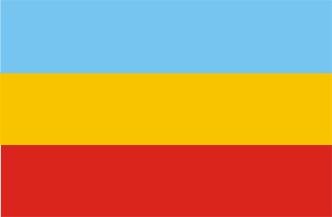
image by Jaume Ollé, 15 September 2001
Adopted: 7 August 1813. Abolished: de facto December 1814. The
colors were used as band and cockarde, and probably also asa
flag, but it is uncertain.
Jaume Ollé

image by Jaume Ollé, 15 September 2001
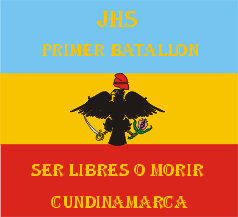
image by Jaume Ollé, 15 September 2001
Reconstruction. Ratio ~4:5. Adopted: 7 August 1813 (According
law rectification of 14 August 1813). Abolished: de facto
December 1814.
Jaume Ollé

image by Jaume Ollé, 15 September 2001
Reconstruction. Adopted: 7 August 1813. Abolished: unknown.
Jaume Ollé
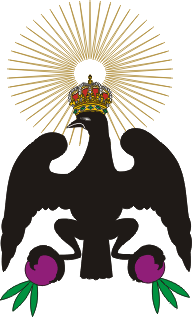
image by Jaume Ollé, 15 September 2001

image by Jaume Ollé, 15 September 2001